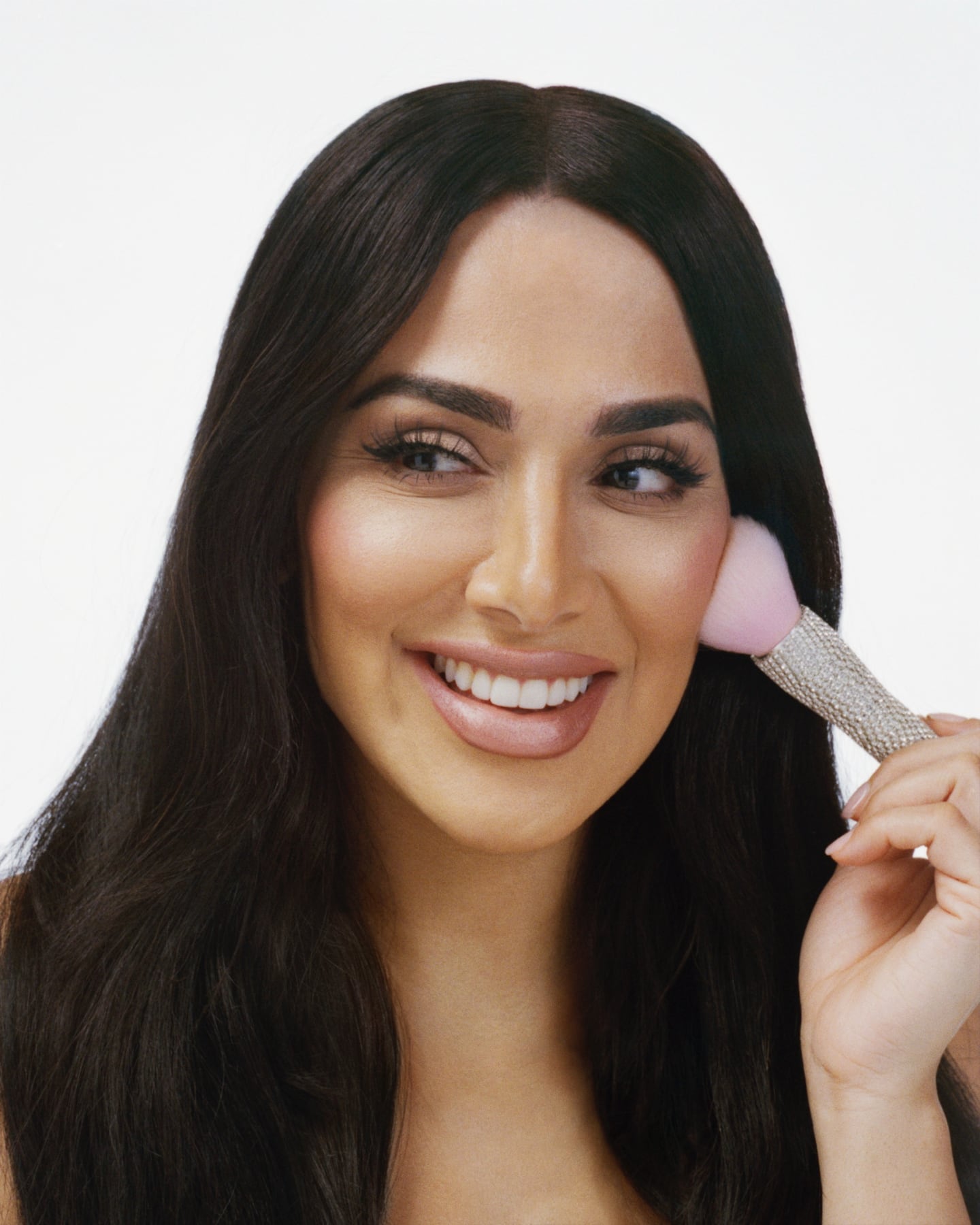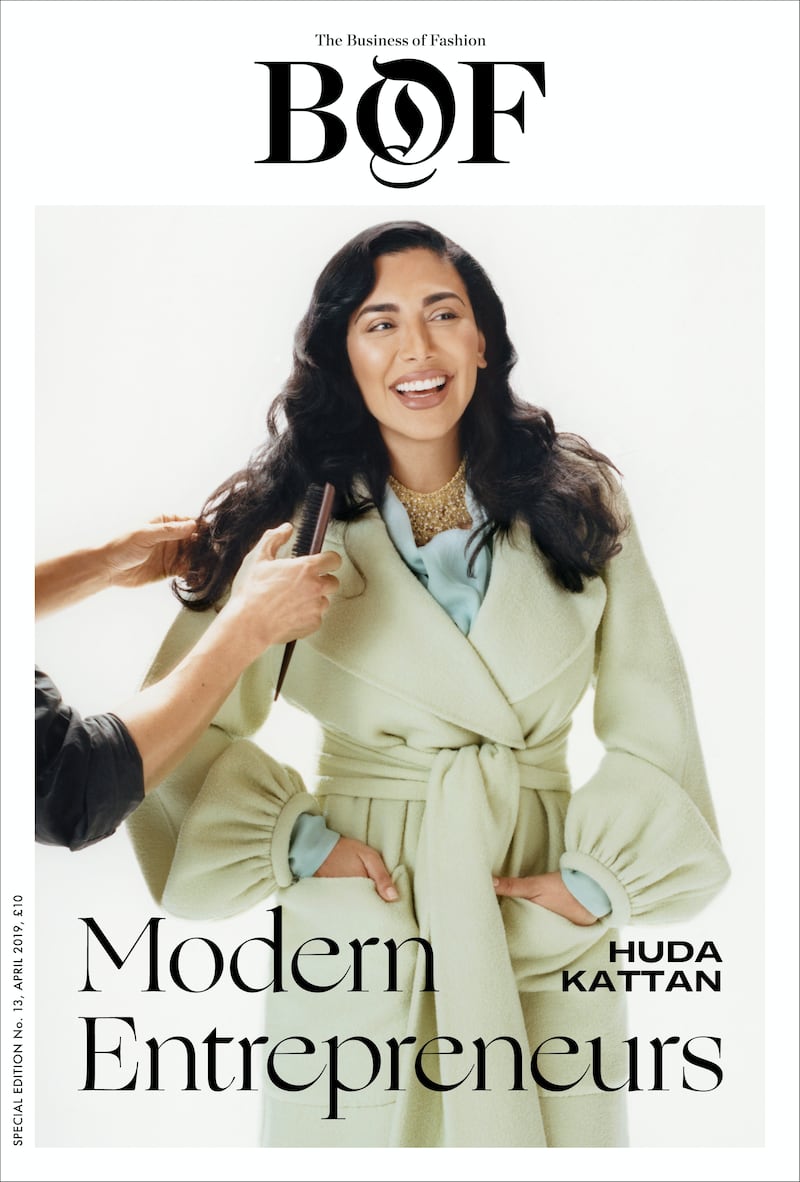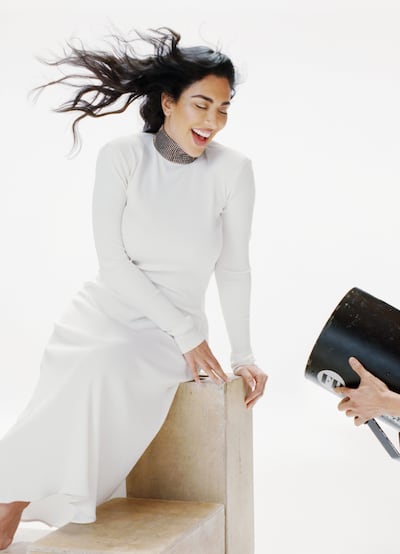
The Business of Fashion
Agenda-setting intelligence, analysis and advice for the global fashion community.

Agenda-setting intelligence, analysis and advice for the global fashion community.

Discover the essential tools for successful entrepreneurship in BoF’s Start-Up School: a resource comprised of a practical guide on topics ranging from fundraising and finding product-market fit to planning an exit; along with supplemental tools, templates and frameworks. Become a member to access.
DUBAI, United Arab Emirates — To say there's a lot of bling in Huda Beauty's headquarters would be an understatement. It's near impossible to walk a few feet without seeing a Himalayan-salt-pink crystal lamp or a rhinestone-encrusted knick-knack (a lipstick, a stiletto, a life-size ice cream cone, you name it).
Then there are the lips. More than anything, it is founder, chief executive and chairwoman Huda Kattan’s affinity for lips that inflects her company’s 22,628-square-foot offices, spread over the 21st and 24th floors of a towering high-rise in the desert city of Dubai. Lips double as signage on bathroom doors and take the form of phones and business cards. There are 1990s, lip-shaped telephones everywhere. Fuchsia, metallic hot pink, red and silver phones — lacquered or bedazzled — are placed on tables, on shelves, at the end of a row of desks. None of them work, but that’s not the point. Kattan is the world’s most famous beauty influencer-turned-entrepreneur and she’s clearly going for a look.
She is perched at the desk in her office, which she uses for everything from product development meetings to dress fittings. It’s her sanctuary, and it’s equipped with a bathroom, powder room and shower. Then there’s the oversized chair covered in disco balls, pink gumball machines, tiaras and Hello Kitty accessories; a couch strewn with an extra-large iridescent Louis Vuitton Speedy bag and PVC Versace totes, and dozens of fluffy, pink makeup brushes, housed in plastic and marble cups, some of them pink with rose-shaped cut-outs. It looks like Barbie’s dream house exploded, with Kattan playing a living version of the famous Mattel doll — that is, if Barbie were Iraqi-American, super rich, hooked on luxury goods and ran a burgeoning beauty empire.
ADVERTISEMENT

Huda Kattan | Photo by Allyssa Heuze for BoF
On the day we meet, Kattan is fighting the tail end of a fever that reached a high of 104 degrees Fahrenheit earlier in the week, but you would never know it judging by her appearance, a slightly more subdued version of the looks she typically posts on Instagram, where @hudabeauty has 35 million followers. Winged eyeliner, subtle contouring and a nude matte lip? On point. Then there’s the $30 nude bodycon dress from Hera Collection that she’s wearing. “I wear this every day,” says Kattan. (“Every day,” a staffer echoes.) “I read that Mark Zuckerberg and Elon Musk have a uniform too.”
Don’t let her look fool you. This 35-year-old entrepreneur is a business powerhouse in the making. “We don’t want to be just a big brand. We want to be the biggest brand,” says Kattan. “We want to be like the next Estée Lauder [Companies]. I know that’s a bold statement, but we do.”
Last year, Huda Beauty did a reported $400 million retail sales, a tiny fraction of the $13.7 billion generated by Estée Lauder Companies in its last fiscal year, but nonetheless impressive just two years after what Kattan calls her company’s “rebirth” in 2016.
According to Kattan, the 2018 revenue number includes sales of one million units of The New Nude Palette, an 18-shade, $65 eyeshadow palette that was sold exclusively at beauty chain Sephora. If you do the math, that means over 15 percent of the company’s total retail sales, or $65 million, came from this single product. Its success is a testament to the power of Huda Beauty, which was able to launch a blockbuster palette despite an industry-wide softening in the category. What’s more, Kattan was told by her retail partners never to launch a new beauty product in November or December, saying it would “tank” because the timing was too close to the holidays. She launched The New Nude Palette on November 1, proving them wrong.
Perhaps more than anything, Kattan is a rule-breaker. “I don’t know the rules. I’ve been colouring outside the lines forever. It comes from a craving… the products that we’re doing, it comes from inside,” says Kattan, who asks her team not to tell her which products will have the biggest profit margins. She admits that some of her products don’t yield great margins (including the aforementioned eyeshadow palette) because, she says, she sacrifices revenue for quality. “I need to create without thinking… about financials or what makes the company money… [because it’s] going to kill my magic. And I [said], ‘Make the products make money, that’s the company’s job.’ But I need to have that creative craving. That’s what I think is really important. We have a lot to express, to innovate — we have a lot to create.”
So how exactly did this makeup artist and beauty blogger build a makeup empire now valued at over $1 billion — “$1.2 billion,” Kattan is quick to note — and one of the hottest acquisition targets in the global beauty industry?
“We give so many fucks. And I say this in almost all the board meetings. We give so many fucks and that’s what makes us different. We give a fuck about the right things,” Kattan says. “There was a time where my sister [Mona Kattan, president of Huda Beauty] really wanted me to be safe all the time, wanted me not to have an opinion all the time, and I was really annoyed. This is not that time anymore. People don’t want that anymore, people want to feel, and, even if it’s not perfect, people want to know.”
ADVERTISEMENT
Artemis Patrick, Sephora’s chief merchandising officer, believes it’s Kattan’s appeal in global markets that has fuelled the brand’s rapid ascent. She is even better known in the Middle East than she is in the US. Indeed, less than half of Kattan’s following comes from the US. The rest comes primarily from Europe, the Middle East, Southeast Asia and India.
Being an influencer with genuine global appeal is a rarity in a space where the popularity of top content creators is typically limited to a particular vertical in a single local market. “Sephora is a global retailer with thousands of stores,” says Patrick. “She fits a unique need for Sephora globally because Huda can relate to consumers all over the world.”
Karen Young, founder of the Young Group, a New York and Paris-based marketing firm that specialises in beauty, credits Kattan’s success to her lack of a traditional marketing strategy. For many consumers interested in the “dramatic makeup category,” as Young calls it, the founder’s approach makes her seem fresh and authentic.
We don't want to be just a big brand. We want to be the biggest brand
“What we’re seeing sometimes is that this notion of ‘having a master plan’ and a strategy can play against indie brands. Especially young millennials and the upper end of Gen-Z — they want no part of this whole corporate, long-term strategy. They want to see, ‘This is how we roll out products,’ and see it quickly. It feels spontaneous,” Young explains. “Huda obviously can pull that off, and that seems to be the way she functions — and she does so with great success.”
Huda Beauty’s Beginnings: From Blog to Brand
Kattan was born on October 2, 1983 in Oklahoma City, three years after her parents relocated to the United States from Iraq. Her family moved around a lot, and by the time she graduated from the University of Michigan-Dearborn in 2008, Kattan had also lived in Cookeville, Tennessee (where she spent her younger years) and Dartmouth, Massachusetts (where she attended high school, worked part-time at Dunkin’ Donuts and met husband Chris Goncalo).
Kattan talks quite a bit about her early days as a makeup artist and blogger. She initially moved to Dubai in 2008, but relocated to Los Angeles for one year after being fired from her job at Robert Half Recruitment in Dubai, which is when she trained at Joe Blasco Makeup Academy. In LA she started her Huda Beauty blog and YouTube channel as a place to share the makeup tips she learned while training, as well as promote the people she was meeting backstage at events. When Kattan returned to Dubai the following year, she got a gig as Revlon’s exclusive makeup artist for the Middle East and worked for brands such as Cartier, Audi and Mercedes-Benz.

Huda Kattan | Photo by Allyssa Heuze for BoF
ADVERTISEMENT
But for years, she struggled to parlay blogging into a real business. She was posting on her blog up to five times a day, mostly about celebrity gossip and beauty, but she says it wasn’t until she started detailing her DIY beauty tips and posting what she called useful and “completely unbiased content” that she started to gain a real following, including repeat visitors who were “super dedicated and blew up the comments section all the time.”
Kattan says her values have not changed since then, and she still uses the same platforms to post tutorials, share beauty tips and showcase products from other brands that she “truly believes in.” There is one big difference though; Kattan has stopped doing paid or sponsored posts. “I did this early in my career to help pay some of our first employees’ salaries, but I no longer do any of these, so the content is 100 percent genuine,” she says.
Kattan founded Huda Beauty’s product line in 2013. Her first product — a collection of fake eyelashes — was sold at Sephora in the Dubai Mall.
In October 2014, about a year and a half after Kattan launched her first products, her distributor, who she declines to name, offered her $1.5 million in exchange for a 60 percent stake in the business. Even though she says she was strapped for cash, she turned down the deal. “I thought maybe the company could potentially die — that was really difficult,” says Kattan. “But we had already been doing about $2 million in sales, so it made no sense. I knew saying no was the right thing.”
A few months later, in February of 2015, Goncalo — who goes by @Silverfox08 on Instagram and “Mr_HudaBeauty” on Snapchat — joined the company as chief operating officer. “That almost led to our divorce,” Kattan quips, but she means it. The first six months after he joined the team were the most challenging, because Goncalo was “really honest” when it came to the business. “He was like, ‘This cannot be a shit show, I’m not signing up for something that is amateur hour.’”
Six months later, in August 2015, Kattan, her husband and their nine employees moved from her home to an office, just as Huda Beauty readied for the launch of a liquid lipstick and lip liner. But the budding company’s plans were derailed when Kylie Jenner debuted her now signature Kylie Lip Kits in November 2015 — just months before Huda Beauty was set to do the same. Kattan says she scratched her plans. Instead, Kattan’s Lip Contour Pencil lip liner debuted solo at Sephora in the Dubai Mall in May 2016.
This marked Huda Beauty’s entry into colour cosmetics, which would prove to be the real engine of the company’s growth. (Kattan had launched nail lacquer in April 2014 and temporary tattoos in January 2016, as they were “easy categories to enter because neither requires stability testing and the minimum order requirement was small.” However, both flopped.)
“Who launches with a lip liner? It’s not really a fun launch,” says Kattan.
But the brand wound up selling 55,000 lip liners in three weeks. Two months later, her Innovative Liquid Matte Lipstick came out, which to date has sold what Kattan describes as tens of millions of units.
Huda obviously can pull that off, and that seems to be the way she functions — and she does so with great success
But she says the company’s real turning point came in 2017, when her blog “really took off.” Since then, her product range has grown to 32 makeup products in 161 colourways across three categories: eyes, lips and complexion. She also has four scents from new fragrance brand Kayali, which launched last October. And, in the second half of this year, Kattan will unveil a skincare range, a response to reader demand on her blog. Currently, colour comprises the vast majority of the business (lip is the best-selling segment within the colour category), but Kattan expects skincare and fragrance to each generate a “significant portion of the business.”
“Skincare is definitely more of a marathon than a sprint, so we are adopting a different approach with it, but we foresee it making up a good portion of revenue,” she says.
Today Huda Beauty has grown into a true family affair, employing not only husband Chris Goncalo, 37, and Mona Kattan, 33, but also Alya Kattan, the oldest of the three siblings at 46, as chief social media officer. Curious title? Alya’s role is said to be critical to the brand, which relies on social media to drive awareness, growth, sales and new customer acquisition. In addition to her 35 million followers on @Hudabeauty as of April 2019, the founder has about 540,000 followers on her personal @Hudakattan account, while her sisters have millions of followers of their own.
“Sharing different types of beauty and giving useful advice is super important to the brand, and that’s really our guiding principle when it comes to what we post on social media. Celebrating new talent is what we thrive on — we love finding makeup artists who we can champion,” Kattan says of the secret to the social following that she’s built, adding that she loves to create “beauty-related skits and memes,” which get a lot of engagement.

Huda Kattan | Photo by Allyssa Heuze for BoF
Huda Beauty Gets Investors
With the exception of the $6,000 older sister Alya gave Huda in 2012 before she launched her fake eyelashes, and borrowing $60,000 from her father, who sold his home in Baghdad to help seed the company, Kattan did not take any money to grow Huda Beauty.
Instead, she says, she helped finance the company’s operations with a handful of well-paying influencer deals, including a brow video for Benefit Cosmetics. These kind of deals can generally pay tens of thousands of dollars, or even six figures for a longer-term partnership.
“I didn’t tell [the team] I wasn’t paying myself money and I was doing those influencer deals for that, I didn’t tell anybody. I didn’t want them to think the company was in turmoil. I knew we were going to be fine,” says Kattan.
Huda Beauty crossed into profitability in 2017, the same year private equity firm TSG Consumer Partners pumped about $200 million into the business in a deal valuing Huda Beauty at $1.2 billion. In order to scale — from a product, operational and logistical standpoint — institutional capital became essential. Kattan now owns 51 percent of the business, TSG owns 16 percent, Mona and Alya own equal parts that amount to about 15 percent and Goncalo owns a small percentage. The rest has been set aside as an option pool for new hires.
Hadley Mullin, senior managing director at TSG Consumer Partners, says Kattan’s social prowess is a key differentiator in a market brimming with makeup brands. “It used to be about who can take the most ads out in InStyle magazine. The indie brands would have to compete with deep-pocketed strategics to get the attention of the consumer,” she says. Today the digital revolution has enabled indie brands to have “just as loud a megaphone” as the much bigger, more established brands. “It’s a key reason why we invested. If you track her Instagram follower base, she lights up the globe,” adds Mullin.
“It’s scary, it’s very scary. I almost walked away from everything while we were going through the transition with the investors,” recalls Kattan. “It was becoming too much, and we were at a point where our cash flows were positive, everything was good… I just didn’t want to get investors. I was afraid, like are they going to try and control me?”
But following the investment, things at Huda Beauty are moving apace. The team based in Dubai is set to increase by 70 percent and the company’s office space in its current building will triple to six floors and include a café and a salon. Huda Beauty has also been busy bulking up its senior leadership team, which now includes a chief supply chain officer from Shiseido, a chief financial officer from Make Up For Ever, a US president and global and US heads of marketing.
Celebrating new talent is what we thrive on — we love finding makeup artists who we can champion
"We are able to optimise the business and grow in ways we haven't been able to before," Kattan says, on the heels of expanding her teams in the US
and the UK. She declines to give specific targets for revenue growth but underscores that deepening existing partnerships with current retail partners will be integral to her strategy going forward. "We have recently signed our exclusivity with Sephora in the US, so we are really focusing on servicing them properly to ensure we are always fully stocked to give customers the best possible experience."
The expanded headquarters will also include a floor dedicated to Kattan’s latest venture HB Investments, a brand incubator that will develop and grow brands from the ground up. HB Angels, created with sister Mona Kattan in 2017, will continue to serve as an early stage investment arm, investing $100,000 or less in start-ups that the Kattans think have legs. “We obviously will have a different approach [than Estée Lauder Companies]. I’m not going to invest in the Too Faced brands, but [in] all these small gems that we think have potential,” says Kattan.
Her longer-term goal is not only to grow the soon-to-be three brands that live under the Huda Beauty umbrella, but also to build a portfolio of in-house labels separate from the Huda brand. The plan is to launch the first two-to-three brands outside the Huda Beauty family within 18 months. Kattan declines to share further details, but says one is skincare and another isn’t even in the beauty category.
“It’s more about individuals right now… We’re trying to create brands with individuals who have dreams. A lot of people come to us and their dreams are not very solid and we’re like, ‘We can’t help you,’” she continues. “Where we can help people is where they have a genuine, specific idea… a unique selling point and they have [a] similar philosophy to Huda Beauty.”
What she means is that founders, like her, need to “give a lot of fucks.”
Related Articles:
[ The Power of Being Yourself: Huda KattanOpens in new window ]
[ Inside Huda Kattan's Blog-to-Brand Beauty EmpireOpens in new window ]

By selling existing formulas under their own name, retailers can tap into the lucrative beauty market without investing in custom formulations. But that doesn’t mean the private label model is an easy win.
The San Francisco-based company is hoping to tap growing consumer demand for financing for cosmetic treatments among other services.
Once thought of as long-term disruptors who would change the way we shop forever, multi-brand online retailers that sell cosmetics, skincare, fragrance and more are facing multiple headwinds.
Prestige makeup is fashion’s category expansion du jour. But even the market’s most powerful players could learn a thing or two from its celebrity-backed competition.